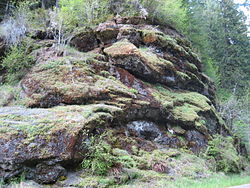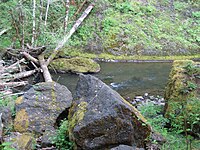Oregon Coast Range
| Oregon Coast Range | |
|---|---|
| Coast Range | |
 The Northern Coast Range, seen from Saddle Mountain in Clatsop County | |
| Highest point | |
| Peak | Marys Peak |
| Elevation | 4,101 ft (1,250 m) |
| Coordinates | 44°30′16″N 123°33′10″W / 44.50444°N 123.55278°W |
| Dimensions | |
| Length | 200 mi (320 km) North–South |
| Geography | |
| Country | United States |
| State | Oregon |
| Subdivisions | Northern Oregon Coast Range, Central Oregon Coast Range and Southern Oregon Coast Range |
| Parent range | Pacific Coast Ranges |
| Borders on | Willamette Valley and Klamath Mountains (California Coast Ranges) |
| Geology | |
| Age of rock | Paleocene and Eocene |
| Type of rock | volcanic and forearc basin |
The Oregon Coast Range, often called simply the Coast Range and sometimes the Pacific Coast Range, is a
The oldest portions of the range are over 60 million years old, with volcanics and a forearc basin as the primary mountain building processes responsible for the range. It is part of the larger grouping known as the Pacific Coast Ranges that extends over much of the western edge of North America from California to Alaska. The range creates a rain shadow effect for the Willamette Valley that lies to the east of the mountains, creating a more stable climate and significantly less rain than the coastal region of the state. To the west where the range over-shadows the Oregon Coast, the range causes more precipitation to fall on that side of the mountains, contributing to the numerous rivers that flow to the Pacific Ocean.
Marys Peak in the Central Coast Range is the highest peak at 4,097 feet (1,248 m). Logging is a major industry in the range in both private and government owned forests. Both the state and federal government manage forests in the Oregon Coast Range. The mountains are home to a variety of wildlife including black bear, elk, deer, beaver, many species of birds, and bats among others. Fish, including salmon and trout, and other aquatic life inhabit the streams and rivers flowing through the range.
Geology

Volcanic activity approximately 66 million years ago in the
Additional basalt flows originated from
The geologic boundaries of the coast range formation extend from southwest Washington state in the north to around the Coquille River in the south where the older and taller Klamath Mountains begin.[1] In the east the mountains begin as foothills forming the western edge of the Willamette Valley and continue west to the coastline and beyond where the basalt formation tapers off into the continental shelf and ends at the continental slope with several banks and basins off shore.[1]
Physiographically, they are a section of the larger Pacific Border province, which in turn are part of the larger
Climate

A mild maritime climate prevails throughout the range with temperature and precipitation varying due to elevation and distance from the coastline.[2] Characteristics of the climate include cool dry summers followed by mild and wet winters.[2] The majority of precipitation accumulates in the form of rain, with snow during the winter months at the higher elevations, but no permanent snow pack.[2] Annual precipitation differs from 60 inches (1,500 mm) in some parts to up to 120 inches (3,000 mm), with the higher amounts coming in the higher elevations.[2] The average high temperature in January is 36.3 °F (2.4 °C), and the average high in July is 61.9 °F (16.6 °C) with temperatures also varying by elevation.[2] The further inland and the more southerly portions have a more Mediterranean climate that is more similar to the climate of the Willamette Valley. The Coast Range creates a rain shadow effect by forcing moisture laden clouds to rise by expelling moisture.[3] This shields the Willamette Valley and causes a less maritime climate with hotter summers and less precipitation than the Oregon Coast.[4]
Sections

The Oregon Coast Range is divided into three separate sections: North, Central, and South. In the south is the oldest portion of the range with formation beginning in the Paleocene era with the Roseburg volcanics, while the newest section is the northernmost portion formed first with the Siletz River Volcanics.[1] The Central and Northern sections contain more sedimentary rocks from the mud, silt, sand, and other volcanic debris than the lower Southern section.[1] Also, the Oregon Coast Range is home to over 50 mammal species, over 100 species of birds, and nearly 30 reptile or amphibian species that spent significant portions of their life cycle in the mountains.[5]
North
Located in the northwest portion of
Central
Located between the Salmon River and the Umpqua River on the north and south, the Central range is bounded by the Willamette Valley on the east and the Pacific Ocean to the west. This approximately 90-mile (140 km)[10] long mountain range contains mountains as high as 4,097 feet (1,248 m) for Marys Peak.[11] Portions of the range are inside the Siuslaw National Forest along with three designated wilderness areas: Drift Creek Wilderness, Cummins Creek Wilderness and the Rock Creek Wilderness. Larger animals that live in these section include deer, elk, bobcat, and bear.[12] Bear are black bear while deer are mule and black-tailed deer species. Other mammals here are mountain beaver, beavers, coyote, mink, river otter, mountain lion, porcupines, skunks, and brush rabbit.[5]
South
The southernmost section of the Coast Range is located in the southwest portion of Oregon between the
Birds living in the Southern Coast Range include a variety of smaller and larger bird species.
Peaks

Five tallest peaks in the Oregon Coast Range:
- Marys Peak, 4,101 feet
- Rogers Peak, 3,706 feet
- Grass Mountain, 3,615 feet, 44°25′25.99″N 123°40′25.46″W / 44.4238861°N 123.6737389°W[16]
- Laurel Mountain, 3,592 feet, 44°55′23.85″N 123°34′23.51″W / 44.9232917°N 123.5731972°W[17]
- Bone Mountain, 3,547 feet
Rivers

The following rivers have their headwaters in the Oregon Coast Range:
- Drains to Pacific Ocean:
- Alsea River
- Coos River
- Coquille River
- D River
- Kilchis River
- Little Nestucca River
- Miami River
- Necanicum River
- Nehalem River
- Nestucca River
- Salmonberry River
- Salmon River
- Siletz River
- Siltcoos River
- Siuslaw River
- Smith River
- Tillamook River
- Trask River
- Umpqua River
- Wilson River
- Yachats River
- Yaquina River

- Drains to Columbia River:
- Drains to Willamette River:
See also
- Coast Range (ecoregion)
References
- ^ a b c d e f g h i j k l m Orr, Elizabeth and William Orr, and Ewart Baldwin. Geology of Oregon. Kendall/Hunt Publishing, 1992, 4th edition.
- ^ JSTOR 2937059.
- ^ Encyclopædia Britannica: orographic precipitation
- ^ Encyclopædia Britannica: Oregon climate
- ^ a b Northwest Forest Plan: Wildlife Habitat Relationships for the Coast Guide. Archived 2007-09-27 at the Wayback Machine
- ^ Peakbagger.com: Rogers Peak
- ^ a b Oregon State University: Northern Coast Range Adaptive Management Area; Chapter 2: Physical and Biological Environment
- ^ a b Tree Dictionary: From the Forest to the Sea: A Story of Fallen Trees
- ^ Biotic Aspection in the Coast Range Mountains of Northwestern Oregon, Ecological Monographs, Vol. 28, No. 1. (Jan., 1958), pp. 21–54. James A. Macnab.
- ^ Peakbagger.com: Central Oregon Coast Range
- ^ "Marys Peak". Geographic Names Information System. United States Geological Survey, United States Department of the Interior. Retrieved 2009-02-19.
- ^ Kerr, Andy. 1980. Last Stand for Oregon's Coast Range. Not Man Apart. Vol. 10, No. 1. January. 7. Archived 2009-01-01 at the Wayback Machine
- ^ "Bone Mountain". Geographic Names Information System. United States Geological Survey, United States Department of the Interior. Retrieved 2009-02-19.
- ^ a b Fish and Wildlife Service: Notice of intent, to conduct scoping meetings
- ^ Spotted Owl Home Range and Habitat Use in Southern Oregon Coast Ranges
- ^ "Grass Mtn Lot". NGS Data Sheet. National Geodetic Survey, National Oceanic and Atmospheric Administration, United States Department of Commerce. Retrieved 2008-11-07.
- ^ "Laurel". NGS Data Sheet. National Geodetic Survey, National Oceanic and Atmospheric Administration, United States Department of Commerce. Retrieved 2008-11-07.
External links
 Media related to Oregon Coast Range at Wikimedia Commons
Media related to Oregon Coast Range at Wikimedia Commons
